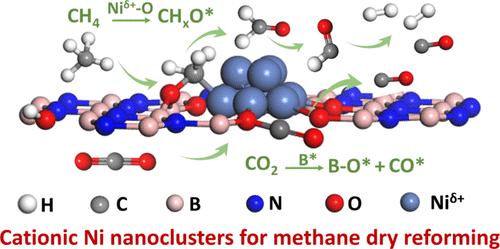当前位置:
X-MOL 学术
›
ACS Catal.
›
论文详情
Our official English website, www.x-mol.net, welcomes your
feedback! (Note: you will need to create a separate account there.)
Generating Cationic Nickel Clusters over Oxygen-Functionalized Boron Nitride to Boost Methane Dry Reforming
ACS Catalysis ( IF 11.3 ) Pub Date : 2024-11-15 , DOI: 10.1021/acscatal.4c05957 Jie Fan, Wen-Cui Li, Lei He, Bowen He, Fan Tang, Zhankai Liu, Dongqi Wang, Xi Liu, Liwei Chen, An-Hui Lu
ACS Catalysis ( IF 11.3 ) Pub Date : 2024-11-15 , DOI: 10.1021/acscatal.4c05957 Jie Fan, Wen-Cui Li, Lei He, Bowen He, Fan Tang, Zhankai Liu, Dongqi Wang, Xi Liu, Liwei Chen, An-Hui Lu

|
Ni-based catalysts are the most promising candidates for methane dry reforming (MDR) reaction but still suffer from deactivation caused by coke-deposition. Herein, we reported a coke resistance MDR catalyst consisting of cationic Ni clusters (Niδ+, 0 < δ < 2) stabilized over oxygen-functionalized boron nitride. A simple method was developed for the fabrication of highly dispersed cationic Ni clusters on boron nitride. The local coordination modes between nickel and boron nitride determine the formation of cationic Ni clusters. We provided detailed spectroscopy and microscopy characterizations to reveal the structure features of these cationic Ni clusters. The average particle size of these clusters is ∼1.7 nm. There are abundant Nixδ+–O–B interfaces on the cationic Ni clusters, which serve as catalytically active sites. Compared to conventional metallic Ni nanoparticles, the cationic Ni clusters exhibited comparable apparent catalytic activity and reduced carbon deposition, particularly operated at 600 °C where unavoidable coke formation from CH4 cracking and the Boudouard reaction usually tends to occur thermodynamically and kinetically. Based on theoretical and experimental evidence, a dynamic synergistic conversion mechanism for CH4 and CO2 on the Nixδ+–O–B interface has been revealed. The oxygen within the Nixδ+–O–B interface could rapidly convert CHx*(x = 1–3) intermediates forming H2 and CO to avoid carbon deposition. CO2 is efficiently activated at boron sites of the Niδ+–O–B interface to regenerate active oxygen species, thereby boosting the conversion of CH4. These insights may shine light on the development of intrinsic coke-free Ni-based catalysts for methane dry reforming in the near future.
中文翻译:

在氧功能化氮化硼上产生阳离子镍团簇以促进甲烷干重整
镍基催化剂是甲烷干重整 (MDR) 反应最有前途的候选者,但仍会因焦炭沉积而失活。在此,我们报道了一种由阳离子 Ni 团簇(Niδ+、0 < δ < 2)组成的抗焦化 MDR 催化剂,该催化剂在氧官能化氮化硼上稳定。开发了一种在氮化硼上制备高度分散的阳离子 Ni 团簇的简单方法。镍和氮化硼之间的局部配位模式决定了阳离子 Ni 团簇的形成。我们提供了详细的光谱学和显微镜表征,以揭示这些阳离子 Ni 团簇的结构特征。这些团簇的平均粒径为 ∼1.7 nm。阳离子 Ni 簇上有丰富的 Nixδ+–O–B 界面,用作催化活性位点。与传统的金属 Ni 纳米颗粒相比,阳离子 Ni 团簇表现出相当的表观催化活性和减少的碳沉积,特别是在 600 °C 下运行,其中 CH4 裂解不可避免地形成焦炭和 Boudouard 反应通常倾向于在热力学和动力学上发生。基于理论和实验证据,揭示了 Nixδ+–O-B 界面上 CH4 和 CO2 的动态协同转化机制。Nixδ+–O–B 界面内的氧可以快速转化 CHx*(x = 1–3) 中间体,形成 H2 和 CO,以避免碳沉积。 CO2 在 Niδ+–O–B 界面的硼位点被有效激活,以再生活性氧,从而促进 CH4 的转化率。这些见解可能会在不久的将来为用于甲烷干重整的本征无焦镍基催化剂的开发提供指导。
更新日期:2024-11-16
中文翻译:

在氧功能化氮化硼上产生阳离子镍团簇以促进甲烷干重整
镍基催化剂是甲烷干重整 (MDR) 反应最有前途的候选者,但仍会因焦炭沉积而失活。在此,我们报道了一种由阳离子 Ni 团簇(Niδ+、0 < δ < 2)组成的抗焦化 MDR 催化剂,该催化剂在氧官能化氮化硼上稳定。开发了一种在氮化硼上制备高度分散的阳离子 Ni 团簇的简单方法。镍和氮化硼之间的局部配位模式决定了阳离子 Ni 团簇的形成。我们提供了详细的光谱学和显微镜表征,以揭示这些阳离子 Ni 团簇的结构特征。这些团簇的平均粒径为 ∼1.7 nm。阳离子 Ni 簇上有丰富的 Nixδ+–O–B 界面,用作催化活性位点。与传统的金属 Ni 纳米颗粒相比,阳离子 Ni 团簇表现出相当的表观催化活性和减少的碳沉积,特别是在 600 °C 下运行,其中 CH4 裂解不可避免地形成焦炭和 Boudouard 反应通常倾向于在热力学和动力学上发生。基于理论和实验证据,揭示了 Nixδ+–O-B 界面上 CH4 和 CO2 的动态协同转化机制。Nixδ+–O–B 界面内的氧可以快速转化 CHx*(x = 1–3) 中间体,形成 H2 和 CO,以避免碳沉积。 CO2 在 Niδ+–O–B 界面的硼位点被有效激活,以再生活性氧,从而促进 CH4 的转化率。这些见解可能会在不久的将来为用于甲烷干重整的本征无焦镍基催化剂的开发提供指导。


















































 京公网安备 11010802027423号
京公网安备 11010802027423号